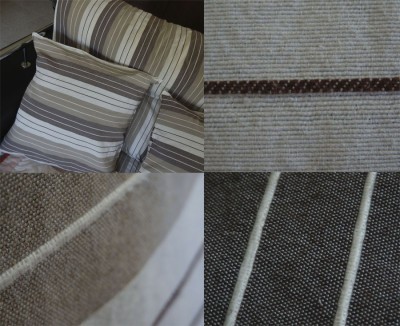Stripey furnishing fabric
This is the second fabric I´ve chosen to analyse. I have looked up close at it and turned it inside out to see the reverse side. I´ve also analysed the weave to see which threads are warp and which are weft.
 In this furnishing fabric you can see 3 different ways to make stripes. It´s very simple and classic furnishing fabric used for cushions and a sofa throw in a weekend cottage outside Barcelona, on the mediterranean coast. I don´t find it particularly innovative or exciting as a woven fabric but even simple fabrics like this often have more to them than initially meets the eye once you look up close.
In this furnishing fabric you can see 3 different ways to make stripes. It´s very simple and classic furnishing fabric used for cushions and a sofa throw in a weekend cottage outside Barcelona, on the mediterranean coast. I don´t find it particularly innovative or exciting as a woven fabric but even simple fabrics like this often have more to them than initially meets the eye once you look up close.
The fabric is almost all woven in plainweave and the design elements are simply broad and narrow stripes in 3 different neutral colours.
So far so good. But even in a simple design like this there are things to learn by looking close-up at the fabric.
Twill stripe
The dark slim stripe consists of 4 picks of weft-faced twill. How do I know? Because, proportionally speaking, you can see a lot more weft than warp. Again, as the photo shows, if you look at the underside of the stripe you see more warp than weft which is always the case with a weft-faced twill.
Why use a weft-faced twill instead of, say, a standard 2/2 twill? Because seeing more – dark – weft – creates a stronger darker stripe effect!
A weft-faced twill always results in a warp-faced twill on the reverse side. Here, on the reverse side of the fabric you can see more warp (white) which means the stripe is not nearly as strong and dark as on the weft-faced side. This was no doubt a conscious decision on the part of the fabric designers.
Weaving several strands of yarn together in a single pick
The other fine stripe (white on a dark background) is different.
Can you see it looks slightly raised and rounded?
In contrast to the 4-pick dark stripe this is just one pick, in plainweave. But the stripe looks almost as thick as the dark stripe. Why? Because the white stripe pick consists of a multi-strand yarn which is a lot thicker than the warp or the normal weft yarns so it takes up more space and creates a textured effect.
Are you a weaver? Why not come on holiday at Anna Champeney Estudio Textil one year? We have holiday accommodation and looms you can use – and there is excellent walking and home-cooked local cuisine here in our little corner of north Spain. It´s a great place to work on a personal textile project or simply enjoy time out in spectacular mountain scenery to refresh yourself, sketch or take photographs to inspire you. Contact us with your ideas.









